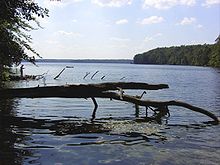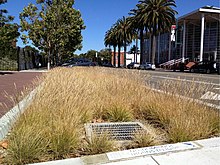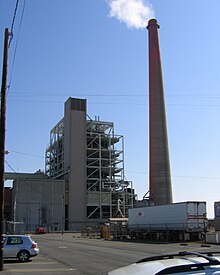Thermal pollution
| Part of a series on |
| Pollution |
|---|
 |

Thermal pollution, sometimes called "thermal enrichment", is the degradation of
When water used as a coolant is returned to the natural environment at a higher temperature, the sudden change in temperature decreases
: 375Sources and control of thermal pollution
Industrial wastewater
In the United States about 75 to 80 percent of thermal pollution is generated by power plants.
Heated water from these sources may be controlled with:
- cooling ponds, man-made bodies of water designed for cooling by evaporation, convection, and radiation
- cooling towers, which transfer waste heat to the atmosphere through evaporation and/or heat transfer
- cogeneration, a process where waste heat is recycled for domestic and/or industrial heating purposes.[9]
One of the largest contributors to thermal pollution are once-through cooling (OTC) systems which do not reduce temperature as effectively as the above systems. A large power plant may withdraw and export as many as 500 million gallons per day.[10] These systems produce water 10°C warmer on average.[11] For example, the Potrero Generating Station in San Francisco (closed in 2011), used OTC and discharged water to San Francisco Bay approximately 10 °C (20 °F) above the ambient bay temperature.[12] Over 1,200 facilities in the United States use OTC systems as of 2014.[7]: 4–4
Temperatures can be taken through remote sensing techniques to continually monitor plants' pollution.[13] This aids in quantifying each plants' specific effects, and allows for tighter regulation of thermal pollution.
Converting facilities from once-through cooling to closed-loop systems can significantly decrease the thermal pollution emitted.[10] These systems release water at a temperature more comparable to the natural environment.
Reservoirs
As water stratifies within man-made dams, the temperature at the bottom drops dramatically. Many dams are constructed to release this cold water from the bottom into the natural systems.[14] This may be mitigated by designing the dam to release warmer surface waters instead of the colder water at the bottom of the reservoir.[15]

Urban runoff
During warm weather, urban runoff can have significant thermal impacts on small streams. As storm water passes over hot rooftops, parking lots, roads and sidewalks it absorbs some of the heat, an effect of the urban heat island. Storm water management facilities that absorb runoff or direct it into groundwater, such as bioretention systems and infiltration basins, reduce these thermal effects by allowing the water more time to release excess heat before entering the aquatic environment. These related systems for managing runoff are components of an expanding urban design approach commonly called green infrastructure.[16]
Retention basins (stormwater ponds) tend to be less effective at reducing runoff temperature, as the water may be heated by the sun before being discharged to a receiving stream.[17]
Effects

Warm water effects
Elevated temperature typically decreases the level of
High temperature limits oxygen dispersion into deeper waters, contributing to anaerobic conditions. This can lead to increased bacteria levels when there is ample food supply. Many aquatic species will fail to reproduce at elevated temperatures.[5]: 179–80
Temperature changes of even one to two degrees
A large increase in temperature can lead to the denaturing of life-supporting enzymes by breaking down
In limited cases, warm water has little deleterious effect and may even lead to improved function of the receiving aquatic ecosystem. This phenomenon is seen especially in seasonal waters. An extreme case is derived from the aggregational habits of the manatee, which often uses power plant discharge sites during winter. Projections suggest that manatee populations would decline upon the removal of these discharges.[22]
Cold water
Releases of unnaturally cold water from reservoirs can dramatically change the fish and macroinvertebrate fauna of rivers, and reduce river productivity.[23] In Australia, where many rivers have warmer temperature regimes, native fish species have been eliminated, and macroinvertebrate fauna have been drastically altered. Survival rates of fish have dropped up to 75% due to cold water releases.[14]
Thermal shock
When a power plant first opens or shuts down for repair or other causes, fish and other organisms adapted to particular temperature range can be killed by the abrupt change in water temperature, either an increase or decrease, known as "thermal shock".[6]: 380 [24]: 478
Biogeochemical effects
Water warming effects, as opposed to water cooling effects, have been the most studied with regard to biogeochemical effects. Much of this research is on the long term effects of nuclear power plants on lakes after a nuclear power plant has been removed. Overall, there is support for thermal pollution leading to an increase in water temperatures.[25] When power plants are active, short term water temperature increases are correlated with electrical needs, with more coolant released during the winter months. Water warming has also been seen to persist in systems for long periods of time, even after plants have been removed.[3]
When warm water from power plant coolant enters systems, it often mixes leading to general increases in water temperature throughout the water body, including deep cooler water. Specifically in lakes and similar water bodies, stratification leads to different effects on a seasonal basis. In the summer, thermal pollution has been seen to increase deeper water temperature more dramatically than surface water, though stratification still exists, while in the winter surface water temperatures see a larger increase. Stratification is reduced in winter months due to thermal pollution, often eliminating the thermocline.[3]
A study looking at the effect of a removed nuclear power plant in Lake Stechlin, Germany, found a 2.33°C increase persisted in surface water during the winter and a 2.04°C increase persisted in deep water during the summer, with marginal increases throughout the water column in both winter and summer.[3] Stratification and water temperature differences due to thermal pollution seem to correlate with nutrient cycling of phosphorus and nitrogen, as oftentimes water bodies that receive coolant will shift toward eutrophication. No clear data has been obtained on this though, as it is difficult to differentiate influences from other industry and agriculture.[26][27]
Similar to effects seen in aquatic systems due to climatic warming of water, thermal pollution has also been seen to increase surface temperatures in the summer. This can create surface water temperatures that lead to releases of warm air into the atmosphere, increasing air temperature.[3] It therefore can be seen as a contributor to global warming.[28] Many ecological effects will be compounded by climate change as well, as ambient temperature rises in water bodies.[11]
Spacial and climatic factors can impact the severity of water warming due to thermal pollution. High wind speeds tend to increase the impact of thermal pollution. Rivers and large bodies of water also tend to lose the effects of thermal pollution as they progress from the source.[25][29]
Rivers present a unique problem with thermal pollution. As water temperatures are elevated upstream, power plants downstream receive warmer waters. Evidence of this effect has been seen along the Mississippi River, as power plants are forced to use warmer waters as their coolants.[30] This reduces the efficiency of the plants and forces the plants to use more water and produce more thermal pollution.
See also
References
- ^ a b "Brayton Point Station Power Plant, Somerset, MA: Final NPDES Permit". Boston, MA: United States Environmental Protection Agency (EPA). May 21, 2021.
- ^ Finucane, Martin (2017-06-01). "Mass. says goodbye to coal power generation". Boston Globe.
- ^ ISSN 0022-1694.
- ^ "Protecting Water Quality from Urban Runoff". Washington, D.C.: EPA. February 2003. Fact Sheet. EPA 841-F-03-003.
- ^ ISBN 978-81-224-1839-2.
- ^ ISBN 9781119304500.
- ^ EPA. May 2014. EPA 821-R-14-002.
- EPA. June 2006. EPA 821-R-06-003. Chapter 2.
- EPA. 1997. p. 24. EPA 310-R-97-007. Archived from the originalon 2011-02-03.
- ^ a b "Freshwater Use by U.S. Power Plants". Cambridge, MA: Union of Concerned Scientists. Retrieved 2021-04-14.
- ^ .
- ^ California Environmental Protection Agency. San Francisco Bay Regional Water Quality Control Board. "Waste Discharge Requirements for Mirant Potrero, LLC, Potrero Power Plant." Archived 2011-06-16 at the Wayback Machine Order No. R2-2006-0032; NPDES Permit No. CA0005657. May 10, 2006.
- S2CID 35998403.
- ^ a b "Cold water pollution". Fishing/Habitat management. Parramatta NSW: Department of Primary Industries, New South Wales Government. 27 April 2016. Retrieved 2021-04-14.
- ^ Mollyo, Fran (15 September 2015). "A happier environment for fish". Phys.org. ScienceX.
- ^ "What is Green Infrastructure?". EPA. 2021-07-29.
- ^ Preliminary Data Summary of Urban Storm Water Best Management Practices (PDF) (Report). EPA. August 1999. p. 5-58. EPA 821-R-99-012.
- ^ Selna, Robert (2009-01-02). "Power plant has no plans to stop killing fish". San Francisco Chronicle.
- ^ "Potrero Power Plant: Site Overview". Pacific Gas & Electric Co. Retrieved 2012-07-17.
- ISBN 978-0-8493-8041-9.
- ^ ISBN 9780128150603.
- ^ "Florida Manatee Recovery Facts". North Florida Ecological Services Office. Jacksonville, FL: U.S. Fish and Wildlife Service. 2016-06-21.
- PMID 32099655.
- ISBN 9781449614867.
- ^ S2CID 110075823.
- ^ Socal, Giorgio; Bianchi, F.; Alberighi, L. (1999). "Effects of thermal pollution and nutrient discharges on a spring phytoplankton bloom in the industrial area of the Lagoon of Venice". Vie et Milieu. 49 (1): 19–31.
- S2CID 128273427.
- ISSN 0921-8181.
- PMID 21069953.
- S2CID 158536102.
- Vinnå, Love Råman (2017). "Physical effects of thermal pollution in lakes". Water Resources Research. 53 (5): 3968–3987. S2CID 59058852.
- Langford, Terry E.L. (1990). Ecological effects of thermal discharges. Pollution Monitoring Series. London: Elsevier Applied Science. ISBN 1-85166-451-3.
- Hogan, Michael; Patmore, Leda C.; Seidman, Harry (August 1973). Statistical Prediction of Dynamic Thermal Equilibrium Temperatures using Standard Meteorological Data Bases (Report). Environmental Protection Technology Series. EPA. EPA 660/2-73-003.
- Thackston, E.L.; Parker, F.L. (March 1971). Effect of Geographical Location on Cooling Pond Requirements (Report). Water Pollution Control Research Series. EPA. EPA 830-R-71-001.
- Edinger, J.E.; Geyer, J.C (1965). Heat Exchange in the Environment (Report). New York: Edison Electric Institute. 65-902.


